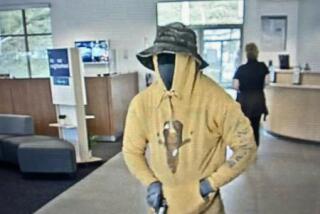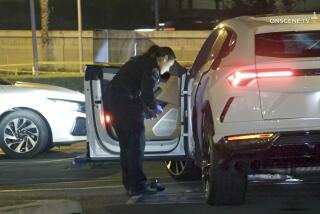For Witness to the Violence, a Close Call
Michael Jones, a 25-year-old man in a Georgetown University T-shirt, red shorts and old white loafers, stood in front of various television cameras Tuesday and calmly told his story, in detail, again and again--how he was using the automatic teller machine, how the two robbers invaded the Wells Fargo Bank, how he fled around the side of the bank and how he went back to hear the shots and watch a wounded gunman stumble outside and fall.
There was, naturally, the question of what-if.
“I was about to go into the bank, because I saw this nice-looking young lady,” Jones said, “but I decided not to because I had my Ready-Teller card.”
He paused and said, “Thank God.”
For two hours, prospective customers and scores of people who had been walking or driving through the busy Crenshaw Boulevard business strip clustered around the crime scene, held back by yellow police-emergency tape.
They stared at the pile of broken glass at the foot of the bank’s obliterated front door. They gasped at the hundreds of spots of dried blood that formed a dreadfully large mosaic on the street where the gunman had been handcuffed. They saw the loot--the two bags of money that he had dropped--lying in circles of police chalk.
A number of them listened to Jones’ description as intently as the assembled news crews.
“You must have done some fast running,” one woman called to Jones in the midst of reporters’ questions.
“I was scared to death, sister,” he said. “ I didn’t have a gun.”
The bank is located among a row of shops on 43rd Place dedicated to beautifying women--a manicurist, a wig shop and a beauty college. Several businesses in this black neighborhood are owned by Koreans, who live elsewhere.
Such incidents “didn’t happen as much in Korea,” said Ki Han, owner of Ebony Wig & Beauty Supply, who was parking his car in front of his store when the shooting began.
Economic Border
The Crenshaw District, an aging but attractive middle-class community, is an economic dividing line. To the west lie the well-to-do neighborhoods of View Park, Baldwin Hills and Windsor Hills. To the east lies drab poverty.
As a result, some of those who stopped to inquire about the shooting brought with them a quality of wary observation.
“They didn’t plan it. Nobody stayed outside,” said Cheryle Johnson. She had been driving on Crenshaw Boulevard with her husband and two children and talked him into stopping the car, where she recognized Jones, a former classmate at Dorsey High School, who told her what he had seen.
“Look at that gun,” said a man, referring to a weapon that the wounded gunman had dropped once he staggered from the bank. “That old raggedy gun he probably sleeps with in the park.”
The thinking among some of the assembled was that the criminals had been waiting for the Federal Armored Express car in Leimert Park, a pretty thumbnail of grass across from the bank that is sometimes populated by beggars and drug sellers.
“When I come to the bank I’m on guard,” said Sylvia Bruswell, a county mental health staff member who works in a building on the other side of Crenshaw Boulevard. She makes sure to park on the side of 43rd opposite the park “because I don’t want to be harassed by people asking for money.”
“I guess they’d (the robbers) been up all weekend and were broke,” said Fannie Patrick, a co-worker of Bruswell’s.
“That’ll teach them,” said another co-worker, Gloria Jackson
“Teach them to work,” Patrick said.
“Are you kidding?” Jackson shot back, attempting to impart a dose of realism.
In the middle of these kinds of conversations, there was another jolt of public violence.
Knife Incident
On the other side of Crenshaw Boulevard, in front of a cafe across from the bank, a woman got into an argument with a male acquaintance, pulled a knife and tried to stab him. Police at the bank raced across the street to intervene but the man suffered a slight wound.
“Everything’s happening on this corner today,” one officer said.
Back in front of the TV cameras, Jones was telling reporters what he had told the police. Having seen the two armed men go into the bank, he had split so fast he forgot to take his automatic teller card and $40 in cash out of the machine. He had run down an alley--inadvertently followed by one of the bandits, who was on his way to meet a cohort in a getaway car. Then, wanting to retrieve his card, he had circled around the bank to watch the front door from a safe distance.
The getaway car “was a blue Camaro, late model, ’76 to ‘79,” he said with police-like efficiency. He described the fleeing gunman expertly.
Jones’ face, while obscured by sunglasses, was becoming very public in a crime in which two suspects were still at large.
“He may be on TV again tonight--face down,” a policewoman who was directing traffic on Crenshaw said soberly.
Pleased to Cooperate
Jones, a former Army infantryman who now makes a living working occasional club dates as a disc jockey, said he was happy to give information to the police.
“I look at it this way,” he said. “They (the robbers) were stupid enough for even trying to do something like this. If they get caught it’s their own fault. I have a job. Why can’t they?”
Two hours after the shooting it was business as usual inside the Topline Nails shop next door to the bank. Attendants performed manicures and pedicures amid idle chatter about the incident.
Lisa Jose, undergoing repairs on three fingernails broken in a volleyball game, said she wondered why police were intently eyeballing her arrival. Later, she learned it was because her car, like that of the bandits, is a Camaro.
“I was planning on changing over (to Wells Fargo) from Security Pacific,” Jose said. “Not anymore.”
Jones, who had planned to spend Tuesday enjoying himself by watching a videotape of Sunday’s Los Angeles Laker playoff game, had a similar thought.
“Next time I’m going to the Wells Fargo in South Gate,” he said. “That one hasn’t been robbed yet.”
Times staff writer Scott Harris contributed to this story.
More to Read
Sign up for Essential California
The most important California stories and recommendations in your inbox every morning.
You may occasionally receive promotional content from the Los Angeles Times.










